 pattern for 47/2 and 47/1 |
 pattern for 71/2 |
Billiards is played with three balls on a 5' x 10' table which has no pocket. It is played basically everywhere except in the US and UK where people play pool or snooker. Billiards is played in Europe, South America, Asia (Japan, Indonesia), North Africa (Egypt, Turkey). There are a white ball, a yellow ball (sometimes a white ball with two dots) and a red ball. One player has the white ball as his cue ball and the other player has the yellow ball. The red is always an object ball. There also exists an Asian game with four balls.
To score a point, the cue ball must contact the two object balls.
Is that it? Yup, it is basically it. The rules of billiards are quite simple, if your cue ball contacts the two object balls, you score a point and play again. This is called straight billiards or straight-rail billiards. In the diagrams I always use the white ball as the cue for the sake of consistency. Straight billiards page.
In 1880, in Paris, there was a game of straight billiards between the French Vignaux and the American Slosson. The latter broke and ran 1 103 points in a row. Then Vignaux ran 1 531 points. Ten years later 3 000 points in a row were scored in San Francisco. These very long runs were tedious. Also there is a problem when in a 500 points a player breaks and runs 500 points without letting his opponent play a single shot.
This is why people looked for ways to make the game harder. One solution was to prevent players from having very long runs where balls would barely move. In balkline, rectangles are drawn on the table and the player cannot keep the two object balls within any rectangle for more than one or two shots. In 47/2, there are three rectangles in the width of the table, so each has a width of 47 cm. The players can play only two shots before they have to make an object ball leave the rectangle (it is allowed to come back.) Hence the name 47/2. 47/1 is similar but the player can play only one shot in any rectangle.
For those who still find it too easy the size of the rectangles can be increased, to have only two rectangles in the width instead of three. This is 71/2.
 pattern for 47/2 and 47/1 |
 pattern for 71/2 |
Note: 48/2 is the name in metric units, it is called 18.2 in English-unit countries.
The idea behind balkline is that constraints had to be introduced in order to make the game harder. Another kind of constraint is used for cushion games. Nothing is drawn on the table. Before contacting the second object ball, the cue ball must contact a rail in one-cushion billiards or three rails in three-cushion billiards. Three-cushion billiards page
In 1939, Ferraz won the straight billiards world championship with an average of more than a hundred. In 1969, Ceulemans from Belgium (the best billiards player ever) won the title with an average run of 180. In 1967, the French Marty was world champion in 47/2 with an average above a hundred. And in 1968, he won at 71/2 at 92 points on average. In 1982 Connesson had an average of 52 at 47/1. In one-cushion, Ceulemans won the world title (he won about 25 world titles) at 15 points on average in 1976. In three-cushion the Swede Blomdahl averaged over 2 points in 1997 to become world champion.
Mathematical model of average runs.
These concepts apply to all games.
When using draw or follow, how hard the ball is hit will change the trajectory. The harder the hit the more the ball will move laterally before rolling forwards or backwards. The trajectory is a curve, while when hit softer the trajectory is flatter.
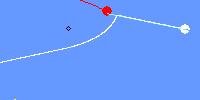 Follow shot hit hard |
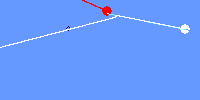 same shot hit softly |
So with maximum spin and hitting hard, cute curves can be obtained.
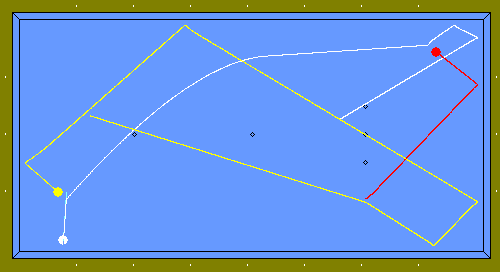
It is often possible to cut a ball or to take it fuller with follow. The player will make a choice depending on the difficulty of the shots (following is easier than a thin cut) and/or for position reasons.
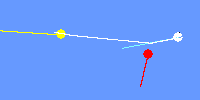 A shot played with a thin hit |
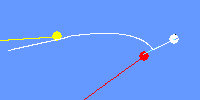 same shot played with a thin hit |
There are two parts to any shot: it is necessary to imagine the shot before making it. In pool there can be two possibilities (two pockets where the ball can be pocketed, a thin cut or a bank shot, etc.) but these alternatives are fairly obvious. It is less so in billiards, especially in three-cushion billiards. Very different shots can be tried and it takes experience and knowledge to see the possible shots and to pick the best one. Some pool shots can be quite tough; but in general it is easy to know what to do, it is only hard to make the ball. In three-cushion there are cases where it is even hard to find a shot that may be doable. So it adds another dimension and another difficulty to the game: the shot has to be imagined before it can be made.
People who have never played billiards may not understand what I mean and may think I am just boldly saying that pool is easy. My point is that it is sometimes harder to find a good shot than to make it. Some easy shots can be well hidden and some obvious shots can be quite tough. In such cases scoring is easy if you choose the right shot. It is therefore possible to miss, not because of poor shotmaking skills, but because of poor shot design.
While billiards is a game in its own right, many pool players see it as a way to improve their position play. To me pool is a useful drill, but some people seem to think otherwise.
In pool or snooker, the player tries to send an object ball to a given spot (a pocket). In billiards, the player tries to send the cue ball to a given spot (where an object ball is). Cue ball control is native to billiards. While in pool cue ball control is secondary or "optional", in billiards it is mandatory. This focus on the cue ball changes the way the game is played, where the object ball must be hit is not determined by where the object ball goes, it is determined by where the cue ball goes. This is a bigger difference than it may seem.
There is not much available in English. Robert Byrne is more or less the only American writing about three-cushion. Nothing seems to be available on straight billiards, balkline or one-cushion as Byrne deals with three-cushion only.
The figures were obtained using the simulation developed by Laurent Buchard (http://perso.wanadoo.fr/laurent.buchard.)
© Mathieu Bouville, October 29 th 2003